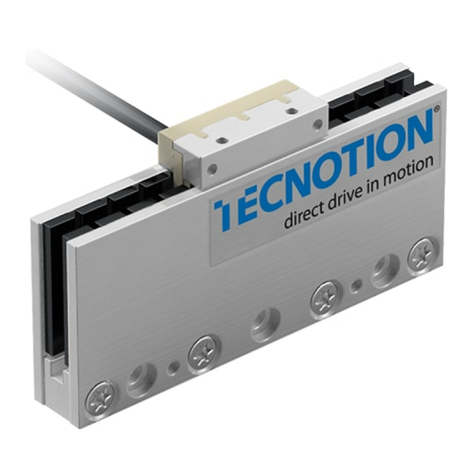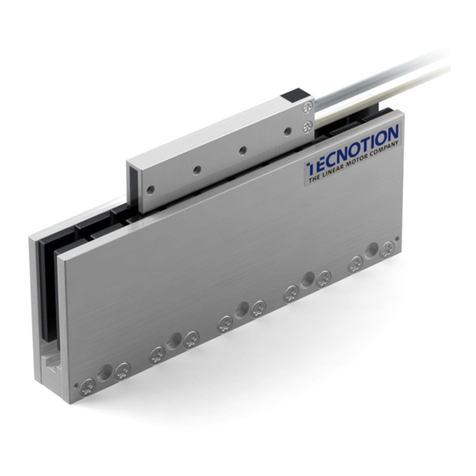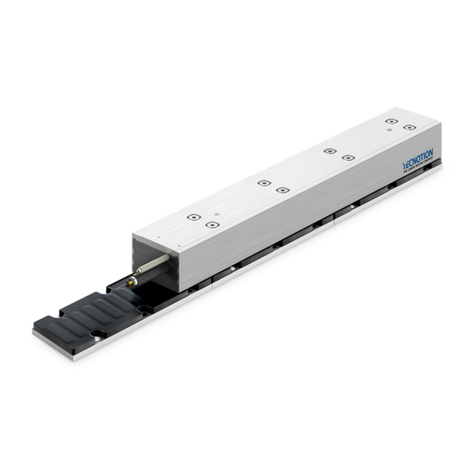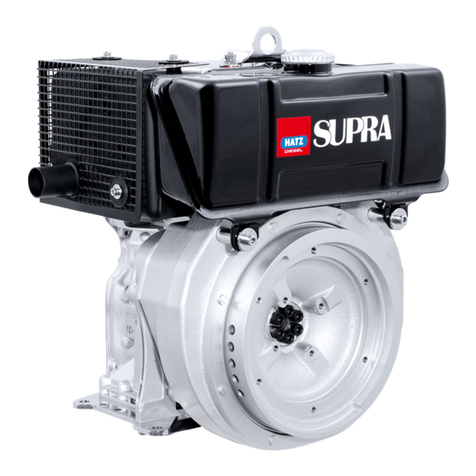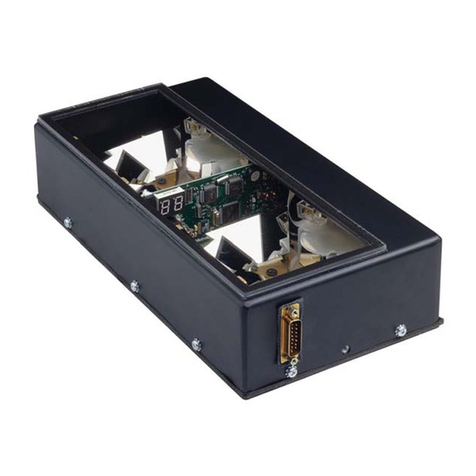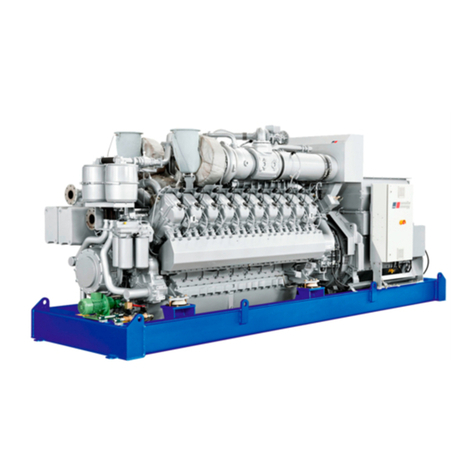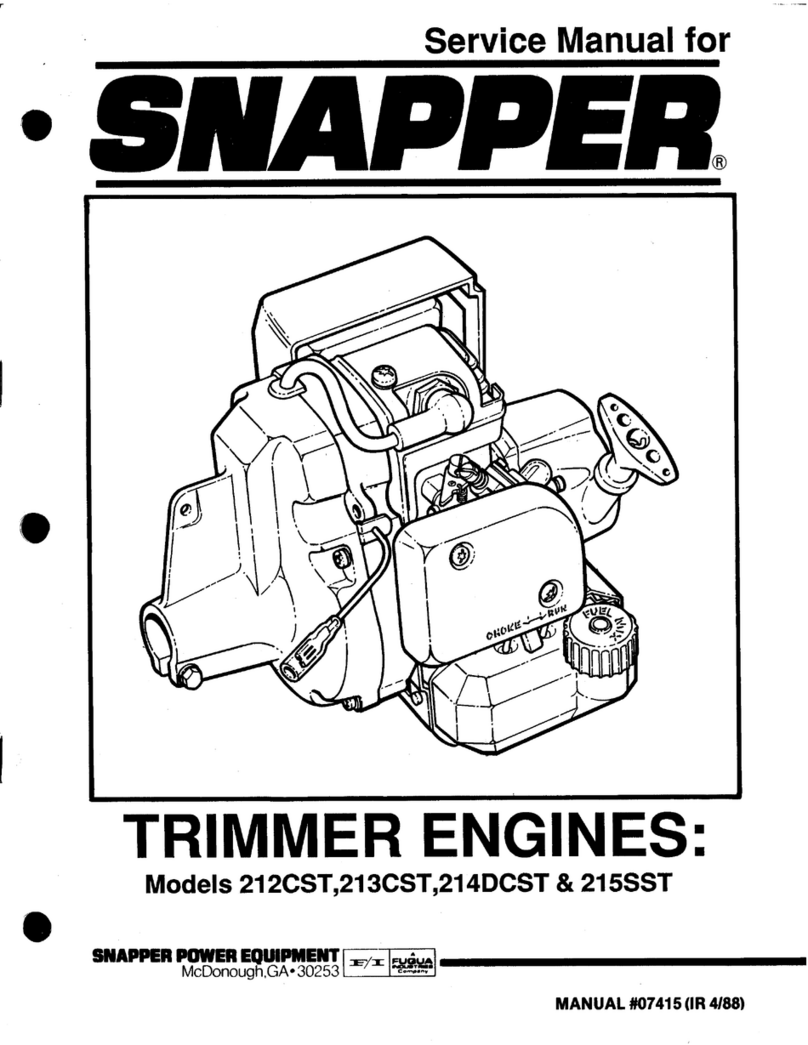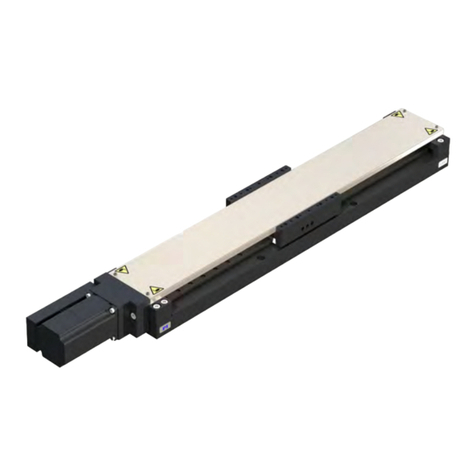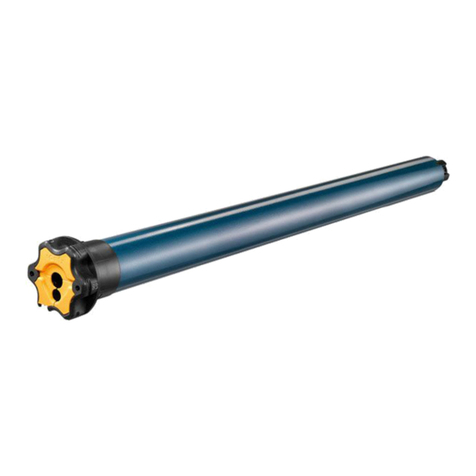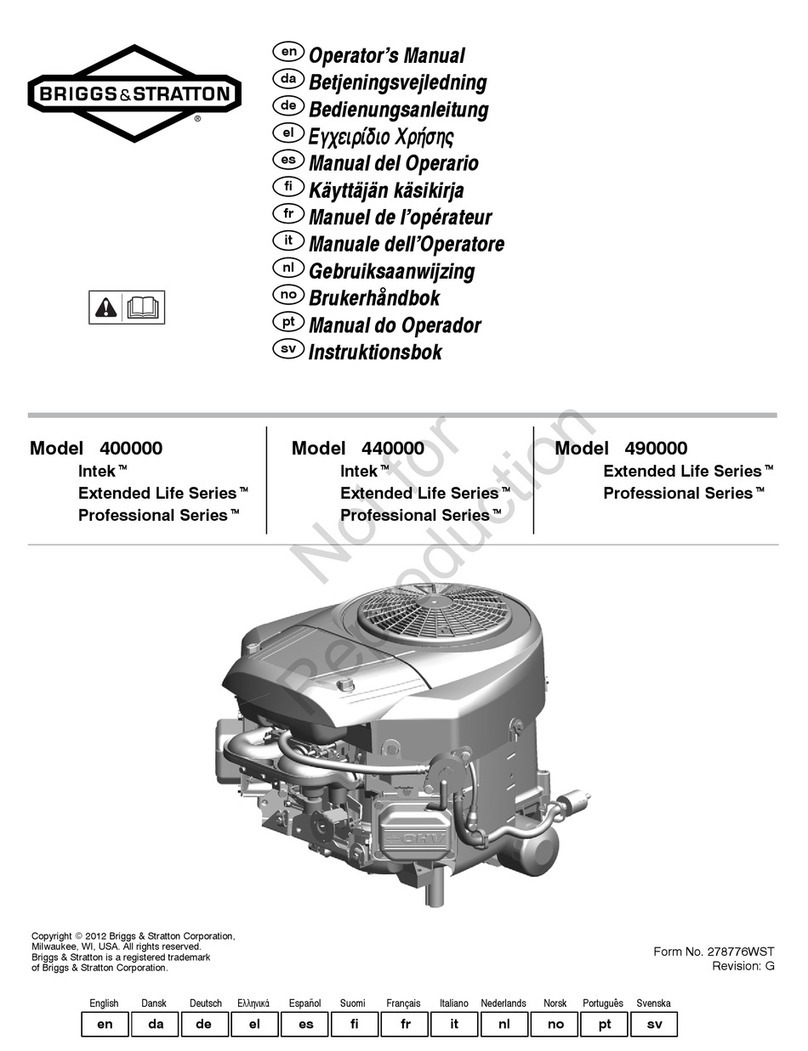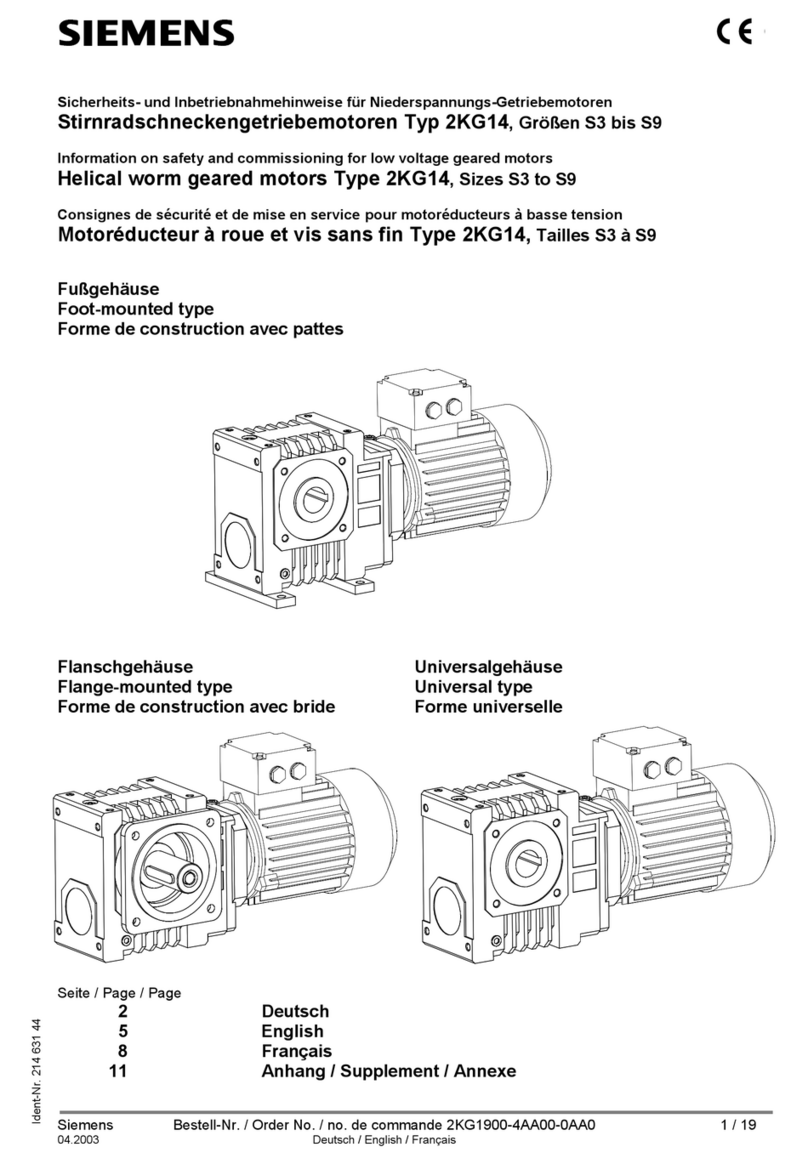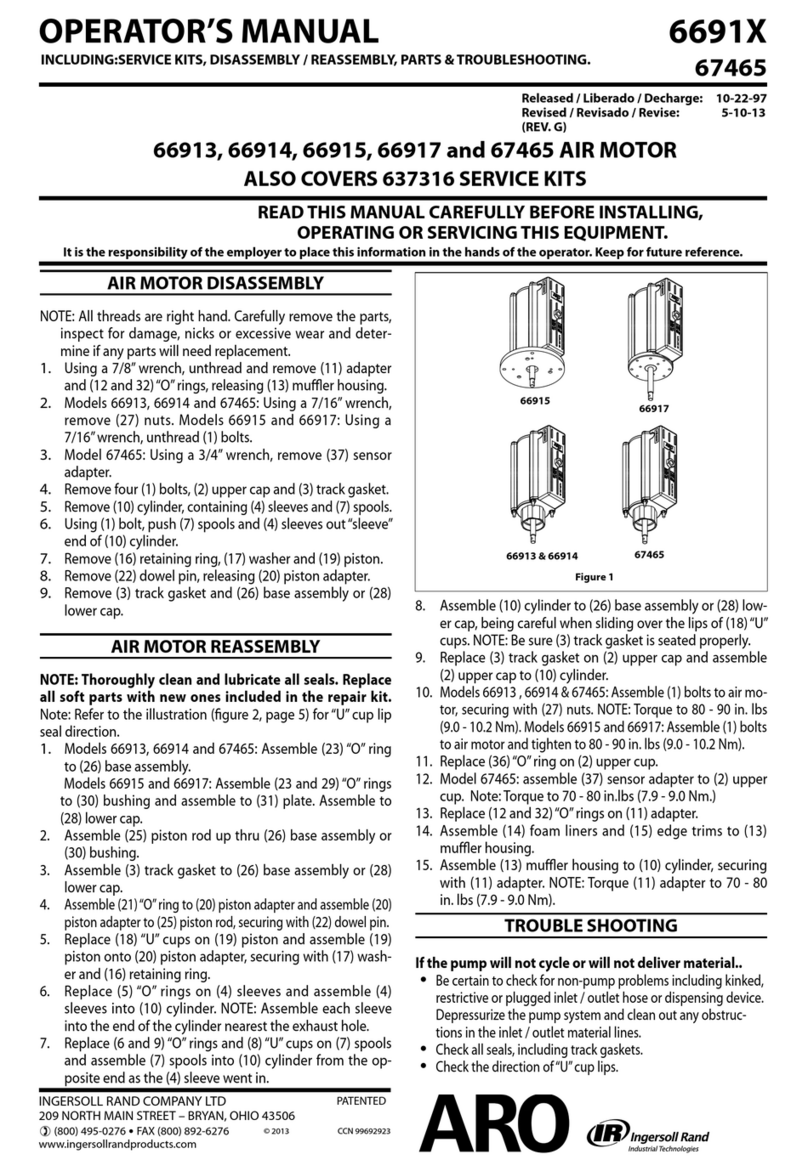Tecnotion QTR 65 Series User manual

Torque motor manual
version 2.2

Torque motor manual - ver. 2.2
2
©2021 Tecnotion BV - All rights reserved - The contents of this document are subject to change without prior notice.
TABLE OF CONTENTS
1. BEFORE YOU START 4
1.1 About this manual 4
1.2 Intended use 4
1.3 Use of symbols 4
1.4 Important notice 4
1.5 Safety warnings 4
1.6 Certification 6
1.6.1 CE Certification
1.6.2 Restriction of Hazardous Substances (RoHS)
1.7 Overview applicable standards 6
2. OVERVIEW & SPECIFICATIONS 7
2.1 Introduction of the motor 7
2.2 Motor family and series 7
2.3 Specifications 7
2.4 Basic components 8
2.4.1 Rotor
2.4.2 Stator
2.4.3 QTL torque motor kit fixation brackets
2.5 Additional components 9
3. MOTOR CONFIGURATION 10
3.1 Safety 10
3.2 Properties 10
3.3 Housing requirements 11
3.4 Mounting 11
3.4.1 Stator
3.4.2 Rotor
3.5 Electrical interface 15
3.5.1 Cable specifications & protective earth
3.5.2 Wiring schemes
3.6 Temperature sensors 18
3.6.1 PTC characteristic
3.6.2 KTY characteristic
3.7 Accessories 20
3.7.1 Digital Hall module
3.7.2 Configuration
4. INSTALLATION 24
4.1 Safety 24
4.2 Introduction 24
4.3 Before you start 25
4.3.1 Cleaning
4.3.2 Axial attraction
4.3.3 Radial attraction
4.4 Mounting options 31
4.4.1 Stator clamping
4.4.2 Stator bonding
4.4.3 Rotor clamping QTR series
4.4.4 Rotor bonding QTR series
4.4.5 Mounting QTL series
4.5 Installation of stator and rotor QTR series 33
4.5.1 Rotor in stator installation
4.5.2 Stator over rotor installation
4.5.3 Installation of the QTL 210 & 290 motor assembly
4.5.4 Installation of the QTL 230 & 310 motor assembly
4.5.5 Final check
4.6 Electrical connections 36
4.6.1 General remarks
4.6.2 Powerlines
4.6.3 Protective earth
4.6.4 Polarization test
4.6.5 Temperature sensor cable wiring
4.6.6 EMC performance

Torque motor manual - ver. 2.2
3
©2021 Tecnotion BV - All rights reserved - The contents of this document are subject to change without prior notice.
4.7 Deinstallation 37
4.8 Additional components 37
4.8.1 Digital Hall module
4.9 Coupling torque motors 37
5. OPERATION 38
5.1 Pre-commissioning 38
5.2 Configuring 38
5.3 Testing 38
5.4 Operational conditions 39
6. TRANSPORT, STORAGE & DISMANTLING 40
6.1 General safety rules for transport, storage & dismantling 40
6.2 Transport & packaging 40
6.3 Storage and transportation 41
APPENDIX - TABLE OF CONTENTS
APPENDIX A 43
Overview and dimensions Torque motor series 43
APPENDIX B 57
QTR 65- digital Hall module and build in dimensions 57
APPENDIX C 67
Material overview 67
APPENDIX D 68
IATA strayfield threshold 68
APPENDIX E 69
CE certification 69
APPENDIX F 70
T/n graphs 65/78 70
APPENDIX F 71
T/n graphs 71
GLOSSARY 77

Torque motor manual - ver. 2.2
4
BEFORE YOU START
©2021 Tecnotion BV - All rights reserved - The contents of this document are subject to change without prior notice.
1. BEFORE YOU START
This is the manual for your Tecnotion motor. Please read this manual very
carefully. The information provided is important for a safe and warranted
installation and operation of the motor. Be sure to have this manual at hand
when installing or working with the motor.
1.1 About this manual
This manual describes the use of a Tecnotion torque motor system. These
motors can be applied in numerous application devices. This manual is
intended for technicians who construct a machine that includes a torque
motor system. It will give insight what aspects to consider for the design
and installation for a torque motor.
1.2 Intended use
A torque motor system is a permanent-magnet direct drive motor that
rotates along an axis. It is intended to be used wherever a rotary movement
is required. Only use this torque motor system as intended, every other use
is not-intended use and therefore not warranted.
1.3 Use of symbols
This symbol describes a tip to inform the user.
This symbol is a non-safety related important notice that the user
should be aware of.
These symbols warn about safety information that should be
respected.
1.4 Important notice
Tecnotion declines all responsibility in case of accident or damage due
to negligence or lack of observance of the instructions described in this
manual. Tecnotion also declines all responsibility in case of accident or
damage in conditions that differ from those indicated in the manual;
Tecnotion also declines all responsibility for damage caused by
improper use of the motor.
Handle the components of the motor with care, packed as well as
unpacked.
Do not expose the magnets to temperatures higher than 70° C. The
magnets may be demagnetized at higher temperatures.
Do not expose the stator to temperatures above 100 no curing° C. The
filler material or wiring may be damaged.
Unpack the motor and check its integrity. If there is any irregularity,
contact the dealer or Tecnotion, signaling the nature of the defects.
Make a note of the serial number. This facilitates the correspondence
with the supplier.
1.5 Safety warnings
Use of magnets
The used magnets show large attraction forces on all ferromagnetic
objects such as iron. These forces cannot be controlled by hand. They
may cause serious jamming danger. Do not bring any soft magnetic
objects (iron) nearer than 25 cm of the magnetic side of the magnets
of the rotor.

Torque motor manual - ver. 2.2
5
BEFORE YOU START
©2021 Tecnotion BV - All rights reserved - The contents of this document are subject to change without prior notice.
Provide sufficient radial and axial centering and guidance to prevent
collision during installation.
Be sure that the stator and rotor are fixed into your machine before
removing the magnetic field protection plates. The stator and rotor
will attract each other during installation. These forces cannot be
controlled by hand. Put the magnetic field protection plates on again
before dismounting them.
Magnetic sensitive objects like banking cards, pacemakers or other
magnetic information carriers may be damaged if they are brought
within 1 m of the magnets (plates or rotor).
If at any time and in any situation there is any doubt about the safety of
the motor, do not use it and contact your supplier.
Mechanical safety
The motor is used as a part of a machine. The user has to take care that
the machine as a whole fulfils all CE requirements.
The motor is powered by a servo amplifier. In case of a power
disruption or fatal error this may automatically result in a free run out
of the motor. Make mechanical precautions to prevent damage on the
motor or your machine in the case of such an event.
The magnets can detach from the rotor when the motor is operated
above its allowed maximum rotational speed. This can cause personal
injury or damage to the motor and the entire application. This speed
varies per motor type. Please set the correct maximum speed for the
installed torque motor. Refer to appendix G for maximum mechanical
speed.
Earthing
Before installing the motor, make sure that the supply mains are
grounded and operate in conformity with the regulations in force.
Make sure that there is an effective protective earth. Make sure that
there is no voltage at the wire terminals before connecting.
An earth connection does not work on non-conducting mounting
surfaces like granite. In these cases the protective earth must be
established by an earthing wire.
Maintenance
Before carrying out checks or doing any maintenance, clear the system
by disconnecting the voltage. Be sure that there is no possibility of
accidental connections.
The components can be damaged when cleaned with a non-
prescribed cleaning agent. Use only isopropanol as a cleaning agent.
Adhesives and activators can damage the stator and rotor.
UV blacklight can cause irreversible damage to the eyes and other
tissue when exposed. When using a UV blacklight installation wear
appropriate protective clothing and glasses.
The motor contains permanent magnets that produce a magnetic stray
field. For transport safety please check chapter 6 for information on
transport.

Torque motor manual - ver. 2.2
6
BEFORE YOU START
©2021 Tecnotion BV - All rights reserved - The contents of this document are subject to change without prior notice.
1.6 Certification
All information about certifications can be found in this chapter. The decla-
ration of conformity or compliance can be found in appendix F.
1.6.1 CE Certification
Tecnotion B.V. declares that all torque motors mentioned in this installation
manual are manufactured in accordance with European directive 2006/95/
EC and in conformity with the following standards, see Table 1.
Table 1: Applicable standards
Standard Name of standard
EN 60034-1: 2010 Rotating Electrical Machines,
Part 1: Rating and performance.
EN 60204-1: 2010 Safety of machinery - Electrical equipment of machines,
Part 1: General requirements
1.6.2 Restriction of Hazardous Substances (RoHS)
Tecnotion B.V. declares to be compliant with the RoHS-guideline. Therefore
Tecnotion ensures that all products are free from lead, cadmium, mercury,
hexavalent chromium, polybrominated biphenyls or polybrominated
diphenyl ethers.
1.7 Overview applicable standards
The table below gives an overview of applicable standards per motor type.
Table 2: Applicable standards per motortype
Series CE RoHS
QTR 65 Yes Yes
QTR 78 Yes Yes
QTR 105 Yes Yes
QTR 133 Yes Yes
QTR 160 Yes Yes
QTR digital Hall module Yes Yes
QTL 210 Yes Yes
QTL 230 Yes Yes
QTL 290 Yes Yes
QTL 310 Yes Yes

Torque motor manual - ver. 2.2
7
OVERVIEW & SPECIFICATIONS
©2021 Tecnotion BV - All rights reserved - The contents of this document are subject to change without prior notice.
2. OVERVIEW & SPECIFICATIONS
This chapter gives an overview of the motor and its components and speci-
fications.
2.1 Introduction of the motor
Tecnotion torque motors are so called frameless torque motors.They can be
applied in numerous application devices. For a fully functional torque motor
system the user needs to provide additional components like an:
■axis,
■bearing system,
■encoder and controller system.
In paragraph 2.4 & 2.5 more information can be found on the basic and
additional components.
2.2 Motor family and series
The torque motor family currently consist of nine diameter types and seven
heights.This covers a continuous torque range of 0.29Nm up to 329Nm.The
figure on the right gives an overview of the torque range.
10Nm1Nm 100Nm 1000Nm
2.6 - 21.9 Nm
5.6 - 55.5 Nm
1.4 - 12.0 Nm
0.57 - 4.41Nm
0.29 ..2.31Nm
9.3 - 91.6 Nm
173 - 346 Nm
389 - 778 Nm
389 - 778 Nm
4.1 - 36.3 Nm
65 - 142 Nm
67 - 147Nm
140 - 305 Nm
151 -331 Nm
2.9 - 28.4 Nm
1.22 - 10.85 Nm
0.64 - 5.47 Nm
0.2 Nm
QTR-78 Series
QTR-105 Series
QTR-133 Series
QTR-160 Series
QTL-210 Series
QTL-230 Series
QTL-290 Series
QTL-310 Series
QTR-65 Series
Ultimate torque Continuous torque
173 - 346 Nm
Figure 1: Torque range
Naming of the motors is done through the convention below:
QTR/QTL-X-XXX-XX-X
Winding type: N, S, Y or Z
For optimization of speed or low busvoltage
Axial height of the stator: 17, 25, 34, 60, 65, 85 or 105 mm
For exact height please review appendix A
Outside diameter of rotor: 65, 78, 105, 133, 160, 210/230 or 290/310mm
For exact height please review appendix A
Magnet type: A or X
X type for improved torque specs
Family designation : QTR / QTL
2.3 Specifications
All torque motors have their own extensive drawings that can be found in
appendix A.

Torque motor manual - ver. 2.2
8
OVERVIEW & SPECIFICATIONS
©2021 Tecnotion BV - All rights reserved - The contents of this document are subject to change without prior notice.
2.4 Basic components
ATecnotion QTR torque motor kit consists of a rotor containing the magnets
and a stator containing the coils. The bigger torque motors are provided
with a temperature sensor. A QTL torque motor has optionally a ring with
cooling channels wrapped around the stator and four brackets and spacers
to fix the rotor and stator in place. In case of the water-cooled motor there
are a total of four brackets. Additionally it has integrated temperature sen-
sors. See Figure 2.
Figure 2: Basic components QTL motor kit
The voltage rating of 300, 600 or 680 Vdc varies per torque motor. Should
another cable exit type or voltage rating be required please contact your
local Tecnotion representative to explore the possibilities. Common
methods of construction of the stator into an application are clamping or
bonding. The torque motor lamination stack surface is made of bare steel
and is prone to corrosion. When the lamination stack surface is not pro-
tected it will show corrosion, this however will not affect performance.
2.4.1 Rotor
The rotor, containing the magnets, is usually the moving part of the torque
motor. The rotor can be fastened into an application by means of bonding,
clamping, or bolting, depending on the motor type. The rotor of QTL motor
can be fastened into an application by means of bolting.
Magnetic field protection ring
The rotor an be supplied with a magnetic field neutralizing protection ring
(QTR-65, QTR-78 and QTL series don’t have a protection ring), see Figure 3. It
functions as a shield for the magnetic forces. With the ring installed the
rotor can be handled safely.
Stator
Rotor
Protection
ring
Stator
Rotor
Protection
ring
Figure 3: Protection ring
2.4.2 Stator
The stator comes in different diameters and heights. It has a separate power
and temperature sensor cable both with a length of 0.5 m. The cable exit
can, depending on the motor type, be in axial or radial direction (see Figure
4). The QTL torque motor has a separate power and temperature sensor

Torque motor manual - ver. 2.2
9
OVERVIEW & SPECIFICATIONS
©2021 Tecnotion BV - All rights reserved - The contents of this document are subject to change without prior notice.
cable both with a length of 2 m. The stator can be fastened into an applica-
tion by means of bolting, bonding, crimping and/or clamping depending
on the motor type.
2.4.3 QTL torque motor kit fixation brackets
The stator and rotor are locked together using fixation brackets, see Figure
2. The function of the fixation brackets is to keep the stator and rotor locked
in place to ensure safety during transport and installation.
Figure 4: QTR motor with axial exit
2.5 Additional components
To construct a complete motion system, additional components are
required. These components are not included when buying a Tecnotion
torque motor. Please review the following minimum required compo-
nents for setting up a complete motion system:
■Power supply with sufficient power and voltage rating.
■Cables and connectors for connecting the torque motor to the drive
system.
■Amplifier and servo drive system.
■Bearing system, with sufficient stiffness and appropriate friction force.
■Mechanical infrastructure for containing the rotor and stator and to
accommodate heat transfer.
Optional:
■Ruler disc and/or encoder system and/or Tecnotion digital Hall module.
■Braking mechanism.
Digital Hall module
The digital Hall module (see below) can be used to determine the electrical
position of the rotor. The module is a replacement for a‘wake-and-shake’of
the motor. It means that the module only functions when the QTR stator is
not powered. This module cannot commutate over the entire speed- and
load bandwidth.

Torque motor manual - ver. 2.2
10
MOTOR CONFIGURATION
©2021 Tecnotion BV - All rights reserved - The contents of this document are subject to change without prior notice.
3. MOTOR CONFIGURATION
This chapter gives information for designing an application driven by a
Tecnotion torque motor. Please take notice of the advice, tips and warnings
in this chapter to make sure the torque motor performs in the best possible
way.
3.1 Safety
Use of magnets
The used magnets show large attraction forces on all ferromagnetic
objects such as iron. These forces cannot be controlled by hand. They
may cause serious jamming danger. Do not bring any soft magnetic
objects (iron) nearer than 25 cm of the magnetic side of the magnets
of the rotor.
Provide sufficient radial and axial centering and guidance to prevent
collision during installation.
Be sure that the stator and rotor are fixed into your machine before
removing the magnetic field protection plates. The stator and rotor
will attract each other during installation. These forces cannot be
controlled by hand. Put the magnetic field protection plates or fixation
brackets on again before dismounting them.
Magnetic sensitive objects like banking cards, pacemakers or other
magnetic information carriers may be damaged if they are brought
within 1 m of the magnets (plates or rotor).
If at any time and in any situation there is any doubt about the safety of
the motor, do not use it and contact your supplier.
Mechanical safety
The motor is used as a part of a machine. The user has to take care that
the machine as a whole fulfils all CE requirements.
Be sure your machine as a whole meets the requirements of all
applicable electrical standards, such as the EN 60204 standard.
The motor is powered by a servo amplifier. In case of a power
disruption or fatal error this may automatically result in a free run out
of the motor. Make mechanical precautions to prevent damage on the
motor or your machine in the case of such an event.
The magnets can detach from the rotor when the motor is operated
above its allowed maximum rotational speed. This can cause personal
injury or damage to the motor and the entire application. This speed
varies per motor type. Please set the correct maximum speed for the
installed torque motor. Refer to appendix G for maximum mechanical
speed.
3.2 Properties
The relevant properties concerning configuration of a torque motor are
described below.
Corrosion
The Tecnotion torque motor lamination stack surface is made of bare steel
and is prone to corrosion. When the lamination stack surface is not pro-
tected it will show corrosion, this however will not affect performance.
Cooling
In order to achieve rated performance, the stator needs to be mounted in a
cooled housing. The full lamination stack needs to be in contact with a 20°C
surface. Insufficient cooling will have an effect on the motor's continuous
torque.

Torque motor manual - ver. 2.2
11
MOTOR CONFIGURATION
©2021 Tecnotion BV - All rights reserved - The contents of this document are subject to change without prior notice.
Air gap
The correct air gap will be ensured by installing the Tecnotion torque motor
according the instructions in this manual.
Thermal conduction
Tecnotion torque motors dissipate heat through the lamination stack. Most
heat dissipates through the larger stack surface, though the lamination
stack shoulders also have an important function. Proper clamping of the
shoulders helps dissipate the heat. Cooling is needed when the motor is
operated at continuous or stall torque.
For smaller motors (17 mm and 25 mm height) shoulder clamping can be
sufficient (see Figure 5). For larger motors it is needed for the motor to lose
its heat through the lamination stack. This can be done by a cooled housing
or heat sink.
For catalogue performance the lamination stack surface needs to be in full
contact with a body or heat sink kept at a maximum of 20°C. When only the
shoulders of the lamination stack are in contact with a cooling/clamping
surface, the available continuous torque is affected. The available continu-
ous torque can be reduced by up to 75%. This reduction is affected by the
motor size, clamping force and various changes in the environment.
Figure 5: Cooling surface indicated in orange
3.3 Housing requirements
Pay attention to the different housing/connection requirements for the var-
ious torque series. When clamping the stator all specifications apply. When
a bonding-connection is used, the angularity does not apply. Always use
the correct concentricity and centering of the rotor in the stator. Centering
of the stator is done on the lamination stack. Rotor centering can be done
on the inside of the rotor.
3.4 Mounting
There are a number of factors to consider when mounting a torque motor.
Most importantly the method of mounting of the stator can affect perfor-
mance. A tradeoff has to be made between thermal conduction, cost of
infrastructure (housing) and ease of (de)installation.
When designing a mounting/housing, these questions can help:
■Does the application use a high continuous load (that requires good
thermal conductivity) or short peak loads (with sufficient downtime for
cooling)?
■What clamping force or shear strength is to be expected to keep the
stator in place?
■Is a quick (de)installation of the motor required?
3.4.1 Stator
Do not clamp the stator on the black polyurethane casting, this can
damage the coils.
Do not center the stator on the black polyurethane casting.

Torque motor manual - ver. 2.2
12
MOTOR CONFIGURATION
©2021 Tecnotion BV - All rights reserved - The contents of this document are subject to change without prior notice.
To ensure a good connection when mounting a stator, pay attention to the
proper alignment, sufficient clamping force/tightening torque and heat
extraction. Thermal properties are affected by the mounting method, either
by variation in the contact surface or by additional thermal resistances
(adhesives).
A
A
B
B
SECTION A-A
SECTION B-B
Figure 6: Heat extraction in orange
QTL 230 and QTL 310 cooling ring
It is necessary to check if the substances present in and around the intended
application do not react with any part of the motor, in particular the NBR
O-rings sealing the cooling ring (see Figure 7) as this could lead to a leakage
of the cooling medium possibly resulting in diminished performance,
short-circuiting, corrosion and/or contamination of the application. It is the
responsibility of the user to design the housing in such a way that it is leak-
proof and compatible with the intended application.
0,2mm
3,2
1
1:2
Error: No reference
Error: No reference
0,5°
SHEET 1 OF 1
Error: No reference
Error: No reference
2
3
4
5
Remove all sharp burrs and sharp edges.
Dimensions after surface treatment.
Error: No reference
Error: No reference
Error: No reference
Error: No reference
Error: No reference
7-11-2018
WATERCOOLING IN- AND OUTLET
COOLING CHANNELS
O-RING
ROTOR
STATOR
HOUSING EXAMPLE
SENSOR CABLE
POWER CABLE
Figure 7: Material overview of QTL 230 and QTL310 with O-rings
3.4.2 Rotor
The main objective when mounting the rotor is proper positioning – axial
and radial – of the motor. Other than positioning the rotor, the proper
clamping/bonding/bolting force needs to be considered. The steel of the
rotor compared to the stator lamination stack allows for higher clamp
forces.
Mounting a rotor requires a strong and rigid axle. Take into consideration
that heat dissipation trough the axle will be minimal. Tecnotion recom-
mends two options when mounting a QTR rotor. The rotor can either be
mounted by clamping it axially or by bonding (see Figure 8), or by bolting in
case of a QTL rotor.

Torque motor manual - ver. 2.2
13
MOTOR CONFIGURATION
©2021 Tecnotion BV - All rights reserved - The contents of this document are subject to change without prior notice.
Figure 8: Bonding surface (left), clamping surface (right)
QTR 65 and QTR 78 housing specification
The following specifications apply when designing a housing for aTecnotion
QTR 65 or QTR 78 stator. The stator's main contact area is the lamination
stack. The lamination stack is used both for cooling and clamping/bonding
purposes. The stator requires a housing with specifications according to
Figure 9 and Table 3.
Align 0.3u0.2
Axle diameter h8
Housing diameter H8
Minimum depth
a0,1 B
a0,3 B
n0,1 B
n0,1 B B
Maximum axle diameter
Figure 9: QTR 65 and QTR 78 housing requirement tolerances for mounting/centering
purposes
Pay attention to the angularity and parallelism when installing a
Tecnotion QTR stator.
Table 3: Housing specification QTR 65 and QTR 78
Motor QTR 65-
17/25 series
QTR 65-
34/60 series
QTR 78-
17/25 series
QTR 78-
34/60 series
Alignment Axial alignment of the rotor in stator must be within 0,3 mm
+/- 0,2 mm
Minimum depth 5.5 mm 7.5 mm 5.5 mm 7.5 mm
Housing diameter 65 mm H8 78 mm H8
Axle diameter 17 mm h8 29 mm h8
Max. axle diameter 23 mm 35 mm
QTR 1xx housing specification
When mounting a QTR 105, QTR 133 or QTR 160 stator different tolerances
apply. See the specifications according to Figure 10 and Table 4. When the
housing meets the tolerances described, the torque motor will perform
best.
AA
SECTION A-A
IDr h7
ODs H9
Alignment 0.3u0.4
Minimum depth
a0,2 A
BB
SECTION B-B
Align 0.3u0.2
IDrotor h8
ODstator H8
Minimum depth
a0,1 B
a0,3 B
n0,1 B
n0,1 B
A
B
Axle diameter h7
Maximum axle diameter
Housing diameter H9
Alignment 0.3u0.4
Minimum depth
a0,2 A
A
Figure 10: QTR 1xx housing requirement tolerances for mounting/centering purposes

Torque motor manual - ver. 2.2
14
MOTOR CONFIGURATION
©2021 Tecnotion BV - All rights reserved - The contents of this document are subject to change without prior notice.
When using a digital Hall module: Tecnotion advices to bond rather
than clamp the stator.
Table 4: Housing specification QTR 105, QTR 133 and QTR 160
Motor
QTR
105-
17/25
QTR
105-
34
QTR
105-
60
QTR
133-
17/25
QTR
133-
34
QTR
133-
60
QTR
160
17/25
QTR
160-
34
QTR
160-
60
Alignment Axial alignment of the rotor in stator must be within 0.3 mm +/- 0.4 mm
Minimum
depth
4.5
mm
5.0
mm
5.5
mm
4.5
mm
5.0
mm
5.5
mm
4.5
mm
5.0
mm
5.5
mm
Housing
diameter 105 mm H9 133 mm H9 160 mm H9
Axle
diameter 56 mm h7 84 mm h7 111 mm h7
Max. axle
diameter 62 mm 91 mm 118 mm
Beware of the maximum temperature when curing the bonding material.
For the stator, no curing above 100°C. Risk of damaging the stator.
For the rotor, no curing above 70°C. Above 70°C, risk of demagnatizing
the magnets.
QTL series housing specification
In order to design the most suitable housing for a particular application the
dimensions of the stator and rotor are given below. The stator of the water
cooled motors and rotor have bolting holes for fastening it to the applica-
tion. This method is advised. The stator of the non-water cooled motors do
not have bolting holes, therefore fixing the motor to the housing should be
done by bonding, crimping or tangential clamping. Axial clamping is not
advised because the lamination stack can be damaged due to compression.
The requirements to fixate the motor within the housing are dependent on
the application and the intended movement profile. The non-water cooled
QTL motors are very similar to the QTR series and the same methods of fixa-
tion, with the exception of axial clamping, can be applied. When designing
the housing of a water cooled motor it is important to take into consider-
ation that the O-ring needs to maintain a seal at all times. Always use the
correct concentricity and centering of the rotor in the stator. Centering of
the stator is done on the rotor ring, not the filler material. Rotor centering
can be done on the inside of the rotor ring. See the specifications according
to Figure 11 and Table 5.
Available
mtemmink
1.6
2:1
mtemmink
2019-04-26
2019-04-25
2
3
4
5
HOUSING
O
H8
AXLE
O
h8
A
aO
0.1 A
MAXIMUM
O
AXLE
915
Available
mtemmink
1.6
2:1
mtemmink
2019-04-26
2019-04-26
2
3
4
5
AXLE
O
h7
HOUSING
O
E8 A
MAXIMUM
O
AXLE
915
aO
0.1 A
Figure 11: QTL 210 and 290 (above) QTL 230, 310, 385 and 485 (below) housing require-
ment tolerances for mounting/centering purposes

Torque motor manual - ver. 2.2
15
MOTOR CONFIGURATION
©2021 Tecnotion BV - All rights reserved - The contents of this document are subject to change without prior notice.
Table 5: Housing specification QTL 210, QTL 230, QTL 290 ,QTL 310, QTL 385 and QTL 485
QTL 210 QTL 230 QTL 290 QTL 310 QTL-385 QTL-485
ID Housing 210 E8 230 H8 290 E8 310 H8 385 H8 485 H8
OD Rotor axle 140 h7 140 h8 220 h7 220 h8 280 h8 366 h8
Max. axle diameter 154 mm 234 mm 304 mm 394 mm
3.5 Electrical interface
Tecnotion torque motors come with various cable configurations. The main
difference can be seen by:
■QTR 65 and QTR 78 motors use 4 ‘flying leads’ for powering the motor.
■QTR 105, QTR 133 and QTR 160 motors have two cables, the larger one
being the power cable, the smaller being the temperature sensor cable.
Both cables being shielded with braided metal.
The temperature sensor cable can be cut off if the sensor is not used.
QTR 65 and QTR 78 have no strain relief, provide proper strain relief in
construction.
The cable exit differs for various Tecnotion torque motors (see Figure 12).
■The 65 mm and 78 mm Tecnotion torque motors use flying lead power
cables. These motors do not have a temperature sensor (cable).
■Tecnotion torque motors of 105, 133 and 160 diameters with a 17, 25 or
34 mm height use a radial cable exit.
■Tecnotion torque motors of 105, 133 and 160 diameters with a 60 mm
height and all QTL motors use an axial cable exit.
QTR 1xx Y and Z have different cable exit dimensions.
Figure 12: Axial flying lead (left), radial shielded cables (middle), axial shielded cables
(right)
QTL torque motor
The QTL torque motor has two cables exiting the stator axially. The larger
orange one being the power cable, the smaller green one being the tem-
perature sensor cable. Both cables being shielded with braided metal.
3.5.1 Cable specifications & protective earth
See Table 6 for cable specifications and identification. If desired you can
shorten these cables and provide them with appropriate connectors.

Torque motor manual - ver. 2.2
16
MOTOR CONFIGURATION
©2021 Tecnotion BV - All rights reserved - The contents of this document are subject to change without prior notice.
Table 6: Cable specification and identification
Motor QTR 65
QTR 78
QTR 105 N
QTR 133 N
QTR 160 N
QTR 105 Y/Z
QTR 133 Y/Z
QTR 160 Y/Z
QTL 210 N
QTL230 N
QTL 290 N
QTL 310 N
Motor height All 17-25-34 60 All 17-25-34 All 65-85-105
Type of cable
4 flying
leads
(3 phases, 1
ground)
Shielded power Shielded
sensor
Shielded
power
Shielded
sensor
Shielded
power
Shielded
sensor
Length 500 mm
Cable diameter
in mm 2.06 6.5 9.5 4.5 6.6 4.5 10.6 6.4
Bending radius
in mm 10.3 42.3 38.4 27 99 27 79.5 48
Rated voltage
Vdc 600 320 600 n/s 320 n/s 680 30
Internally the motor’s protective earth wire is galvanically connected to the
lamination stack. This wire must be connected to the protective earth con-
nector of the servo amplifier.
Provide the motor system with protective earth lines to the amplifier
that are as short as possible..
The details about the QTR 1xx sensor cable wire identification are shown in
Table 7.
Table 7: Sensor cable wire identification QTR 1xx
Sensor cable (color) Connection to servo controller
PTC (white) PTC
PTC (brown) PTC
KTY21 (green) KTY83-122
KTY21 (yellow) KTY83-122
Shield Protective earth
3.5.2 Wiring schemes
Below are the wiring schemes for the different torque motors.
QTR 65 & QTR 78
Servo
amplifier
L1
L3 L2
L1
L2
L3
PE
green/
yellow
Torque motor
Frame
Figure 13: Wiring scheme for QTR 65 and QTR 78
Table 8: Power cables wire identification QTR 65 and QTR 78
Power cable 17/25/34/60 Connection to servo controller
3-phases
L1 black
3-phasesL2 red
L3 white
Protective earth green/yellow Protective earth

Torque motor manual - ver. 2.2
17
MOTOR CONFIGURATION
©2021 Tecnotion BV - All rights reserved - The contents of this document are subject to change without prior notice.
QTR 1xx N+Y
Servo
amplifier
L1
L3 L2
PTC
KTY
L1
L2
L3
PE
green/
yellow
white
brown
yellow
green
Torque motor
Frame
Figure 14: Wiring scheme for QTR 105, QTR 133 and QTR 160
Table 9: Power cables wire identification QTR 1xx N+Y
Powercable 17/25/34 60 Connection to servo controller
3-phases
L1 black black '1'
3-phasesL2 red black '2'
L3 white black '3'
Protective earth green/yellow Protective earth
Shield Protective earth
QTR 1xx Z
Servo
amplifier
L1
L3
L2
PTC
KTY
L1
L2
L3
PE
green/
yellow
white
brown
yellow
green
Torque motor
Frame
Figure 15: Wiring scheme for torque Z windings
Table 10: Power cables wire identification QTR 1xx Z
Powercable 17/25/34 60 Connection to servo controller
3-phases
L1 black black '1'
3-phasesL2 red black '2'
L3 white black '3'
Protective earth green/yellow Protective earth
Shield Protective earth

Torque motor manual - ver. 2.2
18
MOTOR CONFIGURATION
©2021 Tecnotion BV - All rights reserved - The contents of this document are subject to change without prior notice.
QTL series
L1
L3 L2
L1
L2
L3
PE
green/
yellow
Torque motor
Frame
+
-
red
yellow
green
blue
PT1000
PT1000
PT1000
PTC
PTC
PTC
brown
black
Figure 16: Wiring scheme for QTL series
Table 11: Power cables designation QTL series
Phase Cable designation
L1 U/L1/C/L+
L2 V/L2
L3 W/L3/D/L-
PE GN/YE
Table 12: Sensor cable wire identification QTL series
Component Colour
PTC Brown
PTC Black
PT1000 (1) + Red
Not used Orange
PT1000 (2) + Green
PT1000 (3) + Yellow
PT1000 common - Blue
Not used Violet
3.6 Temperature sensors
Tecnotion can supply three types of temperature sensors with its torque
motors:
■PTC-sensors
■KTY-sensors
■PT1000
The PTC-sensor can be used as a cut-off sensor when the maximum tem-
perature is exceeded. The KTY-sensor can be used for monitoring purposes
as well.

Torque motor manual - ver. 2.2
19
MOTOR CONFIGURATION
©2021 Tecnotion BV - All rights reserved - The contents of this document are subject to change without prior notice.
Tecnotion QTR 65 and QTR 78 torque motors do not use any
temperature sensors.
Tecnotion QTR 105, QTR 133 and QTR 160 stators are equipped with
two temperature sensors, one PTC-1k-type and one KTY83-122 type.
Tecnotion QTL 210, QTL 230, QTL 290 and QTL 310 stators are equipped
with 3 x PTC 1kΩ in series and 3 x PT1000 in parallel.
In cases where long peak currents are demanded, the thermal response
time of the stator is too long to ensure a proper overheating protection by
the sensors. The temperature sensors can ensure a proper protection up to
an Irms of 45% of the ultimate current of the motor. This corresponds with a
temperature increase of 4.5°C/s. These long peak current conditions can
occur for example during an accidental run or by taking a new axis in con-
trol. In this case I2t protection is essential to prevent the stator from over-
heating. In almost all controllers an I2t protection can be set in the software.
3.6.1 PTC characteristic
The PTC-1k type is a sensor which has a very sudden resistance rise near the
critical temperature of the stator of 110°C. The PTC-1k type is almost a digi-
tal indicator: temperature below vs. above critical temperature. Therefore it
is very useful for signaling over temperature without requiring sensitive
electronics.
It is not possible to obtain a direct temperature signal from this sensor. At
room temperature the PTC has an electrical resistance <100 Ω. When the
temperature rises to the critical temperature the resistance will increase
rather uniformly up to 1000 Ω. Above this temperature the resistance
increases exponentially. 1000 Ω is the switching resistance. The amplifier
should immediately stop the power supply when this resistance is exceeded.
In this way overheating and motor damage can be prevented.
T (°C)
R (Ω)
10 30 50 70 90 110 130 150 180
101
102
103
104
105
106
107
Figure 17: Temperature dependence of the PTC-1k sensor
3.6.2 KTY characteristic
The KTY83-122 sensor has a rather stable and slow temperature coefficient
as shown in Figure 18. The sensor can supply a temperature reading in the
whole range. Therefore it is useful to monitor the coil temperature during
tests and to decide whether the thermal margins are enough to guarantee
error-free running of the machine under certain conditions.
Disadvantage of the sensor is that it requires sensitive and accurate elec-
tronics to obtain a reliable reading. Please configure the sensor according to
the wiring scheme in Figure 19 to attain a correct read out.

Torque motor manual - ver. 2.2
20
MOTOR CONFIGURATION
©2021 Tecnotion BV - All rights reserved - The contents of this document are subject to change without prior notice.
Table 13: KTY83-122 characteristic values
T (°C) 20 25 30 40 50 60 70 80 90 100 110 120 130
RNOM (Ω) 972 1010 1049 1130 1214 1301 1392 1487 1585 1687 1792 1900 2012
2000
1500
1000
500
050 100 °C
Ω
RKTY
RMIN
RNOM
RMAX
T
R
Figure 18: Temperature dependence of the KTY83-122 sensor
12k
4k7 KTY
Usupply
Usignal
Figure 19: Wiring scheme for KTY83-122 sensor
0
200
400
600
800
1 0 0 0
1 2 0 0
1 4 0 0
1 6 0 0
0 2 0 4 0 6 0 8 0 1 0 0 1 2 0 1 4 0
Resistance [Ohm]
Temperature [°C]
PT1000 resistance graph
Figure 20: PT 1000 sensor characteristics
3.7 Accessories
3.7.1 Digital Hall module
Tecnotion QTR motors can be equipped with a digital Hall module for‘wake
and-shake’functionality. (digital Hall module is not available for QTL series).
Before the motor is switched on this digital Hall module can determine the
position and direction of rotation of the rotor. For drawings of the digital
Hall module see appendix B.
The QTR digital Hall modules can only be used as a wake-and-shake replace-
ment. This means that the module only functions when the torque stator is
not powered.
This manual suits for next models
21
Table of contents
Other Tecnotion Engine manuals
Popular Engine manuals by other brands
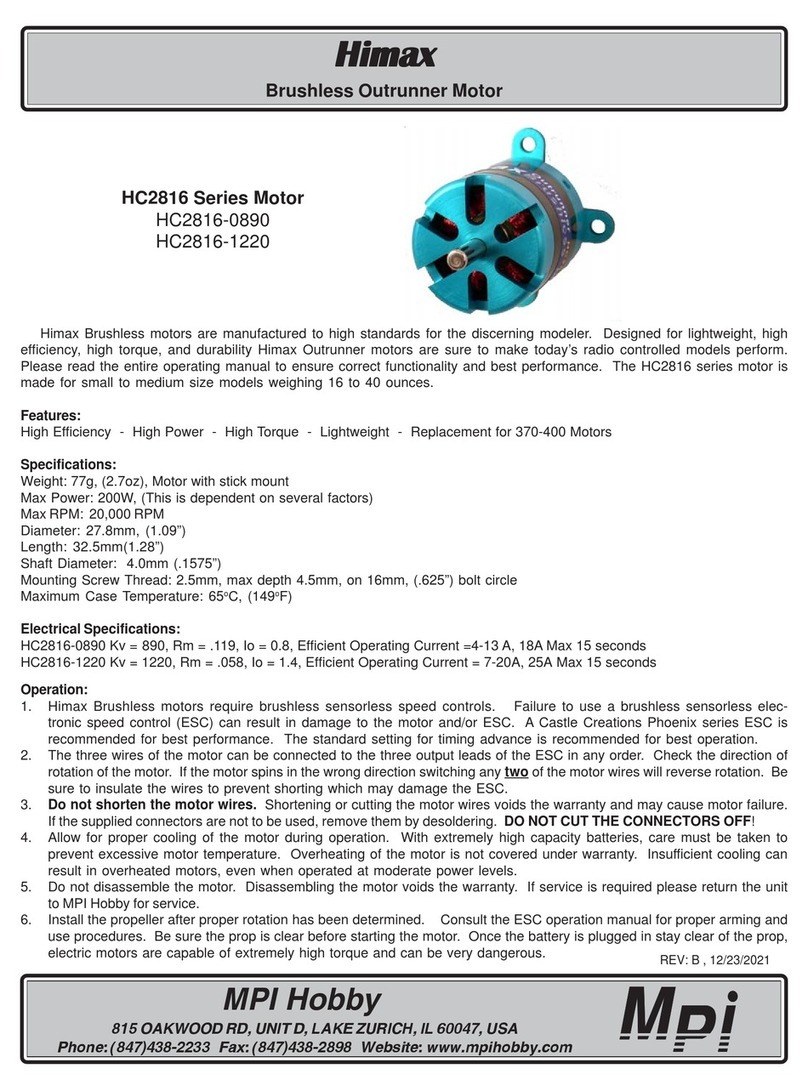
MPI
MPI Himax HC2816 Series manual
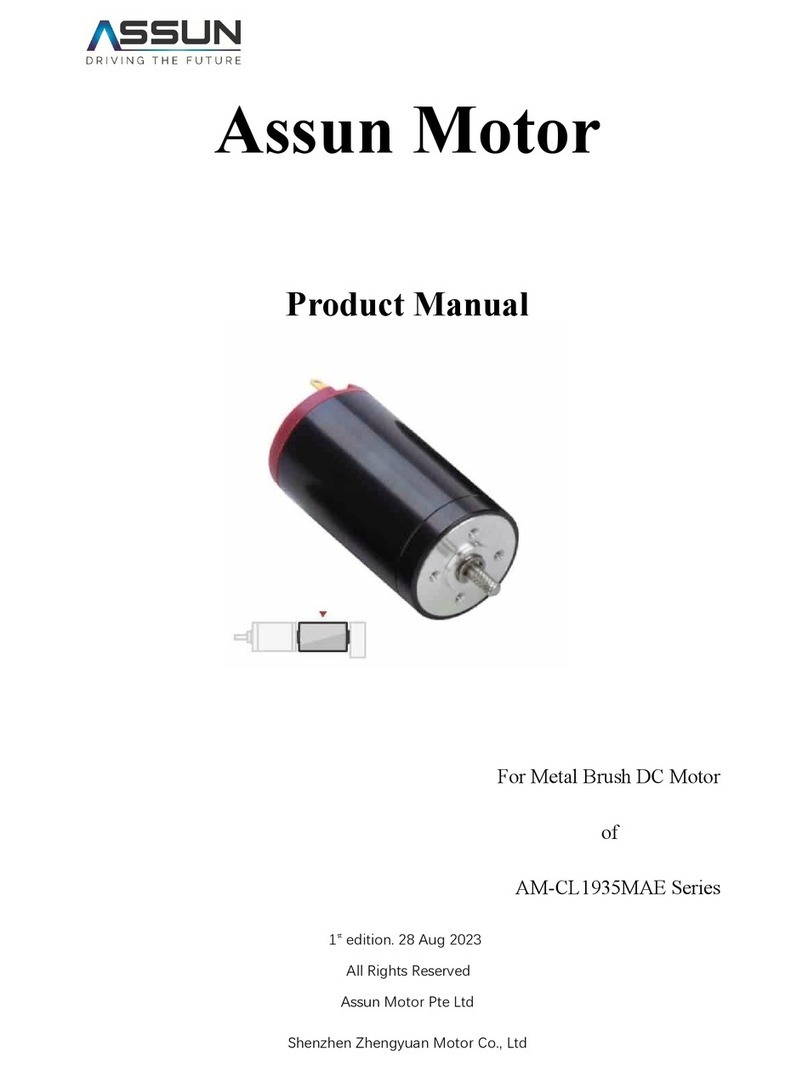
Assun
Assun AM-CL1935MAE Series product manual

Robin America
Robin America EH12-2, EH17-2, EH25-2 parts manual
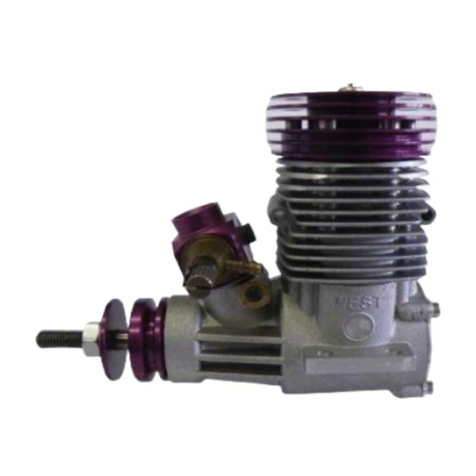
Weston UK
Weston UK WEST EUROTECH 52 V2 instructions

Nice
Nice Era Fit S Instructions and warnings for installation and use

Ingersoll-Rand
Ingersoll-Rand AF0860 Series Operator's manual
